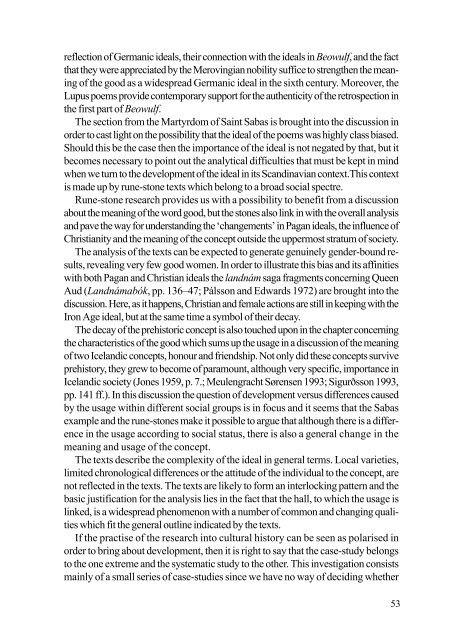Beowulf - Institutionen för arkeologi och antik historia
Beowulf - Institutionen för arkeologi och antik historia
Beowulf - Institutionen för arkeologi och antik historia
Create successful ePaper yourself
Turn your PDF publications into a flip-book with our unique Google optimized e-Paper software.
eflection of Germanic ideals, their connection with the ideals in <strong>Beowulf</strong>, and the fact<br />
that they were appreciated by the Merovingian nobility suffice to strengthen the meaning<br />
of the good as a widespread Germanic ideal in the sixth century. Moreover, the<br />
Lupus poems provide contemporary support for the authenticity of the retrospection in<br />
the first part of <strong>Beowulf</strong>.<br />
The section from the Martyrdom of Saint Sabas is brought into the discussion in<br />
order to cast light on the possibility that the ideal of the poems was highly class biased.<br />
Should this be the case then the importance of the ideal is not negated by that, but it<br />
becomes necessary to point out the analytical difficulties that must be kept in mind<br />
when we turn to the development of the ideal in its Scandinavian context.This context<br />
is made up by rune-stone texts which belong to a broad social spectre.<br />
Rune-stone research provides us with a possibility to benefit from a discussion<br />
about the meaning of the word good, but the stones also link in with the overall analysis<br />
and pave the way for understanding the ‘changements’ in Pagan ideals, the influence of<br />
Christianity and the meaning of the concept outside the uppermost stratum of society.<br />
The analysis of the texts can be expected to generate genuinely gender-bound results,<br />
revealing very few good women. In order to illustrate this bias and its affinities<br />
with both Pagan and Christian ideals the landnám saga fragments concerning Queen<br />
Aud (Landnámabók, pp. 136–47; Pálsson and Edwards 1972) are brought into the<br />
discussion. Here, as it happens, Christian and female actions are still in keeping with the<br />
Iron Age ideal, but at the same time a symbol of their decay.<br />
The decay of the prehistoric concept is also touched upon in the chapter concerning<br />
the characteristics of the good which sums up the usage in a discussion of the meaning<br />
of two Icelandic concepts, honour and friendship. Not only did these concepts survive<br />
prehistory, they grew to become of paramount, although very specific, importance in<br />
Icelandic society (Jones 1959, p. 7.; Meulengracht Sørensen 1993; Sigurðsson 1993,<br />
pp. 141 ff.). In this discussion the question of development versus differences caused<br />
by the usage within different social groups is in focus and it seems that the Sabas<br />
example and the rune-stones make it possible to argue that although there is a difference<br />
in the usage according to social status, there is also a general change in the<br />
meaning and usage of the concept.<br />
The texts describe the complexity of the ideal in general terms. Local varieties,<br />
limited chronological differences or the attitude of the individual to the concept, are<br />
not reflected in the texts. The texts are likely to form an interlocking pattern and the<br />
basic justification for the analysis lies in the fact that the hall, to which the usage is<br />
linked, is a widespread phenomenon with a number of common and changing qualities<br />
which fit the general outline indicated by the texts.<br />
If the practise of the research into cultural history can be seen as polarised in<br />
order to bring about development, then it is right to say that the case-study belongs<br />
to the one extreme and the systematic study to the other. This investigation consists<br />
mainly of a small series of case-studies since we have no way of deciding whether<br />
53








